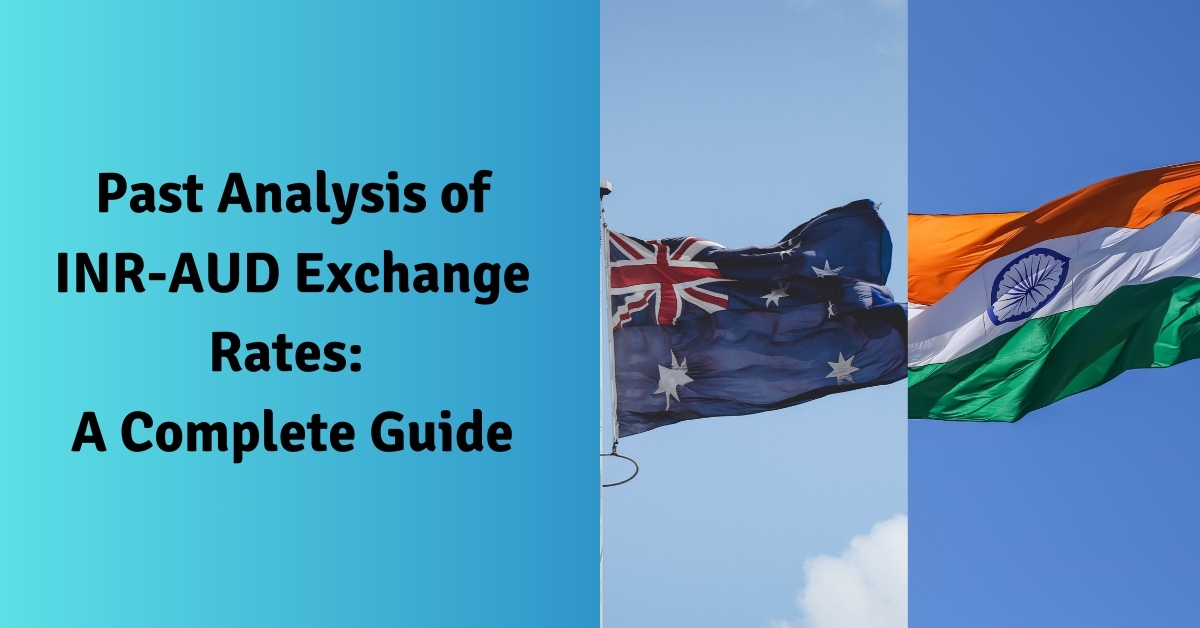Past Analysis of INR-AUD Exchange Rates: A Complete Guide

Examining the historical relationship between the Indian Rupee (INR) and Australian Dollar (AUD) exchange rates offers crucial knowledge for individuals engaged in cross-border commerce, tourism, or financial investments. Scrutinizing past data enables you to recognize patterns, forecast market shifts, and execute well-calculated financial choices.
Real-Time Example: INR to AUD Exchange Rate Analysis
Let’s examine a practical illustration of how to interpret historical exchange rate information for INR to AUD:
Time Period: January 2022 – September 2024
Key Events:
- The AUD’s value fluctuations due to global raw material pricing, specifically iron ore and coal
- India’s financial reforms and changes in monetary strategies
- Worldwide economic restoration following the pandemic and international political strains
Analysis:
- AUD’s performance has been directly correlated with raw material prices. Being a major coal and iron ore exporter, Australia saw its currency strengthen against INR as demand for these materials increased in 2022 and 2023.
- India’s economic policy adjustments, including interest rate modifications and inflation control measures, created varied effects on INR, occasionally strengthening and other times weakening against AUD.
- International political tensions and post-pandemic recovery created significant exchange rate volatility between INR and AUD, as investors sought secure currency options.
Why Examine Historical Exchange Rate Information?
Past exchange rate data delivers valuable perspectives on currency behavior over time, important because:
- Pattern Recognition: Historical analysis reveals currency movement patterns, helping predict future trends and improve exchange, investment, and market strategy decisions.
- Factor Analysis: Historical information shows how various elements like economic indicators, political situations, and global market shifts influence currency values.
- Strategic Planning: Historical exchange rate insights help investors, companies, and traders make calculated decisions about currency trading, international investments, and strategic planning.
Methods for Analyzing Historical INR to AUD Exchange Rate Data
Understanding historical exchange rate information involves several crucial steps:
- Timeline Selection: Pick an appropriate time frame matching your research goals and required detail level.
- Data Source Verification: Use dependable historical exchange rate sources like financial websites, central banks, and established financial institutions.
- Trend Visualization: Create visual representations of historical rates to identify patterns and understand long-term movements.
- Event Identification: Document major events affecting exchange rates during your chosen period.
- Relationship Analysis: Study connections between rate changes and external factors like economic indicators, political events, or market sentiment.
Conclusion
Start exploring historical INR to AUD exchange rate data today. Discover patterns, identify trends, and make evidence-based decisions using past performance data. Whether you’re an experienced trader or new learner, understanding historical data is essential for navigating currency market complexities.
FAQs
1. What determines the frequency of INR-AUD exchange rate changes?
Ans- INR-AUD rates experience multiple daily fluctuations influenced by economic releases, global political events, central bank announcements, and market attitudes. These variations respond to interest rate adjustments, inflation levels, trade balances, and overall economic health of both nations.
2. Which elements drive INR-AUD exchange rate variations?
Ans- Rate fluctuations stem from various factors including economic metrics like GDP expansion, inflation rates, and interest rates in both countries, plus international political events, bilateral trade relationships, and market sentiment. Central bank policies and currency market interventions also impact exchange rate dynamics.
3. Are there methods to secure better INR-AUD exchange rates?
Ans- Improved rates may be obtained by evaluating different banks, currency exchange providers, and online platforms. Additionally, timing exchanges during favorable market conditions and utilizing competitive rate services with minimal fees can help secure better deals.
4. Do banks and currency exchange services offer different INR-AUD rates?
Ans- Rate variations exist between banks and exchange services due to different markups, service charges, and operational costs. While banks provide convenience and security, specialized currency exchange services or digital platforms might offer more competitive rates and reduced fees.
5. How does the present INR-AUD rate compare with historical values?
Ans- To evaluate current rates against historical data, access reliable sources such as financial websites, central banks, or currency exchange platforms. Analyzing past trends helps understand rate positioning and supports informed transaction or investment decisions.
6. How can I use historical exchange rates for future planning?
Ans- You can use past rates to spot patterns or trends, which helps in predicting future movements. This information is useful when planning currency exchanges, investments, or international trade.
7. What tools can help me track historical INR-AUD exchange rates?
Ans- Many online platforms and financial websites offer historical exchange rate data. You can also use apps or services from banks and financial institutions to track currency trends.
8. How does inflation impact the INR-AUD exchange rate?
Ans- Higher inflation in one country can reduce the value of its currency, which can weaken its exchange rate against another currency. So, inflation in India or Australia affects the INR-AUD exchange rate.
9. Why does the price of raw materials affect the AUD?
Ans- Australia is a major exporter of raw materials like coal and iron ore. When global demand for these rises, the Australian Dollar strengthens, impacting the INR-AUD rate.
10.How do global political events influence the INR-AUD exchange rate?
Ans- Political events like elections, trade agreements, or conflicts can create uncertainty in the market, causing fluctuations in the exchange rate as investors react to potential risks.



